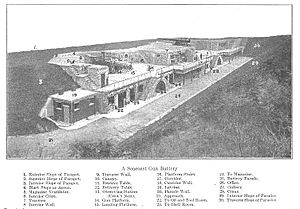Fort Armistead facts for kids

Fort Armistead was a United States Army fort built to protect the coast. It was active from 1901 to 1920. This fort helped defend Baltimore, Maryland from attacks by sea.
Contents
History of Fort Armistead
Fort Armistead was built between 1897 and 1901. It was part of a big plan called the Endicott Program. This program aimed to build strong defenses along the American coast. Other forts in the Baltimore area from this time include Fort Howard, Fort Carroll, and Fort Smallwood.
Why the Fort Was Built
Fort Armistead is located in the Hawkins Point part of Baltimore. It was named after Major George Armistead. He was a brave commander at Fort McHenry during the War of 1812. In September 1814, the British Royal Navy attacked Baltimore. This battle inspired Francis Scott Key to write the poem that became "The Star-Spangled Banner," America's national anthem.
Guns and Defenses
Fort Armistead had four main gun areas, called batteries:
- Battery Winchester had one large 12-inch gun. This was a special "disappearing gun" that could hide after firing.
- Battery McFarland had three 8-inch disappearing guns.
- Battery Irons had two 4.72-inch guns on mounts.
- Battery Mudge had two 3-inch guns that could be hidden.
Each battery was named after a brave military officer. Battery Winchester was named for James Winchester, a hero from the Revolutionary War. Battery McFarland honored Daniel McFarland, who died in the War of 1812. Battery Irons was named for Joseph Irons, killed in the Mexican–American War. Battery Mudge was named for Robert R. Mudge, who died fighting the Seminoles.
The fort also had a special building called a mine casemate. This was a control center for a minefield placed in the harbor. These mines could explode if enemy ships tried to pass.
Changes Over Time
Battery Irons was added quickly in 1898. This was because of the Spanish–American War. People worried the Spanish fleet might attack the U.S. East Coast. The Endicott Program was not finished yet, so these guns were a fast way to boost defenses. Battery Irons' guns were later moved to Fort Ruger in Hawaii in 1913.
When America joined World War I in 1917, many guns were taken from coastal forts. They were planned for use on the battlefields in Europe. Most of these heavy guns from Baltimore were removed in 1917–1918. They were never returned to the forts.
Battery McFarland's 8-inch guns were removed in 1917. They were meant to be used as guns on trains. Battery Winchester's 12-inch gun was sent to Fort Wadsworth in Staten Island, New York. It replaced another gun that had been sent away. Fort Armistead's active service ended in 1920. The 3-inch guns from Battery Mudge were scrapped.
During World War II (1939-1945), the military used the fort site again. The United States Navy stored ammunition there. From 1952 to 1954, a battery of four 90 mm anti-aircraft guns was placed at the site.
Fort Armistead Today
After World War I, the fort was no longer needed by the United States Department of War. The U.S. Army left it in 1923. Five years later, in 1928, it became a park for the City of Baltimore.
Over the years, the park has been improved. A fishing pier and a parking lot were added. From 1975 to 1977, the Francis Scott Key Bridge was built. This large bridge, part of Interstate 695, now stands over the old fort site.
The old gun batteries are still there. They are partly buried underground. Tunnels and deep trenches provide access to them. Sometimes, shrubs and small trees grow over them. The fort and its tunnels are open for people to explore. However, the city does not maintain them much, so there is often graffiti and trash.


